DODGE GRAND CARAVAN 2009 5.G Owners Manual
Manufacturer: DODGE, Model Year: 2009, Model line: GRAND CARAVAN, Model: DODGE GRAND CARAVAN 2009 5.GPages: 535, PDF Size: 18.61 MB
Page 91 of 535
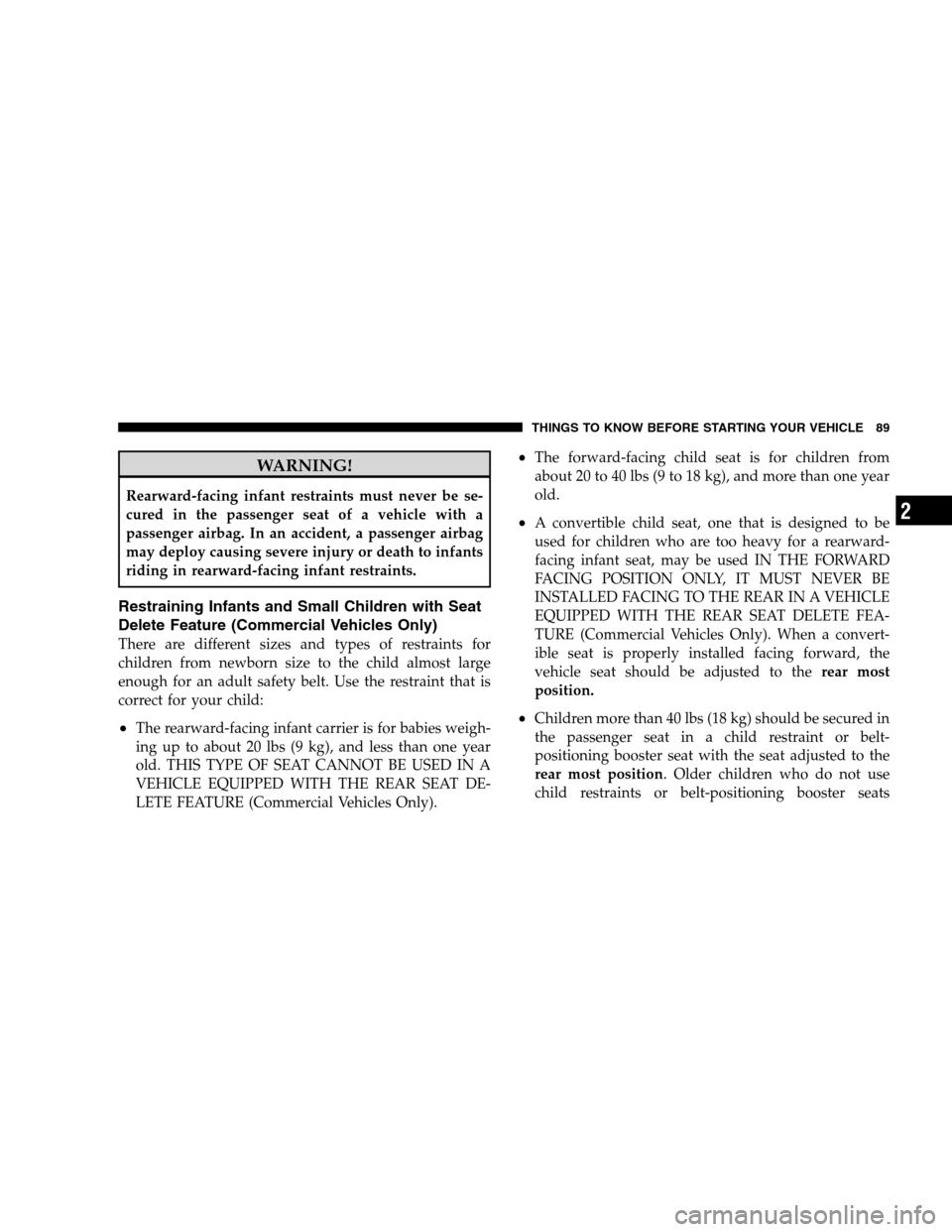
WARNING!Rearward-facing infant restraints must never be se-
cured in the passenger seat of a vehicle with a
passenger airbag. In an accident, a passenger airbag
may deploy causing severe injury or death to infants
riding in rearward-facing infant restraints.
Restraining Infants and Small Children with Seat
Delete Feature (Commercial Vehicles Only)
There are different sizes and types of restraints for
children from newborn size to the child almost large
enough for an adult safety belt. Use the restraint that is
correct for your child:
The rearward-facing infant carrier is for babies weigh-
ing up to about 20 lbs (9 kg), and less than one year
old. THIS TYPE OF SEAT CANNOT BE USED IN A
VEHICLE EQUIPPED WITH THE REAR SEAT DE-
LETE FEATURE (Commercial Vehicles Only).
The forward-facing child seat is for children from
about 20 to 40 lbs (9 to 18 kg), and more than one year
old.
A convertible child seat, one that is designed to be
used for children who are too heavy for a rearward-
facing infant seat, may be used IN THE FORWARD
FACING POSITION ONLY, IT MUST NEVER BE
INSTALLED FACING TO THE REAR IN A VEHICLE
EQUIPPED WITH THE REAR SEAT DELETE FEA-
TURE (Commercial Vehicles Only). When a convert-
ible seat is properly installed facing forward, the
vehicle seat should be adjusted to the
rear most
position.
Children more than 40 lbs (18 kg) should be secured in
the passenger seat in a child restraint or belt-
positioning booster seat with the seat adjusted to the
rear most position. Older children who do not use
child restraints or belt-positioning booster seats
THINGS TO KNOW BEFORE STARTING YOUR VEHICLE 89 2
Page 92 of 535
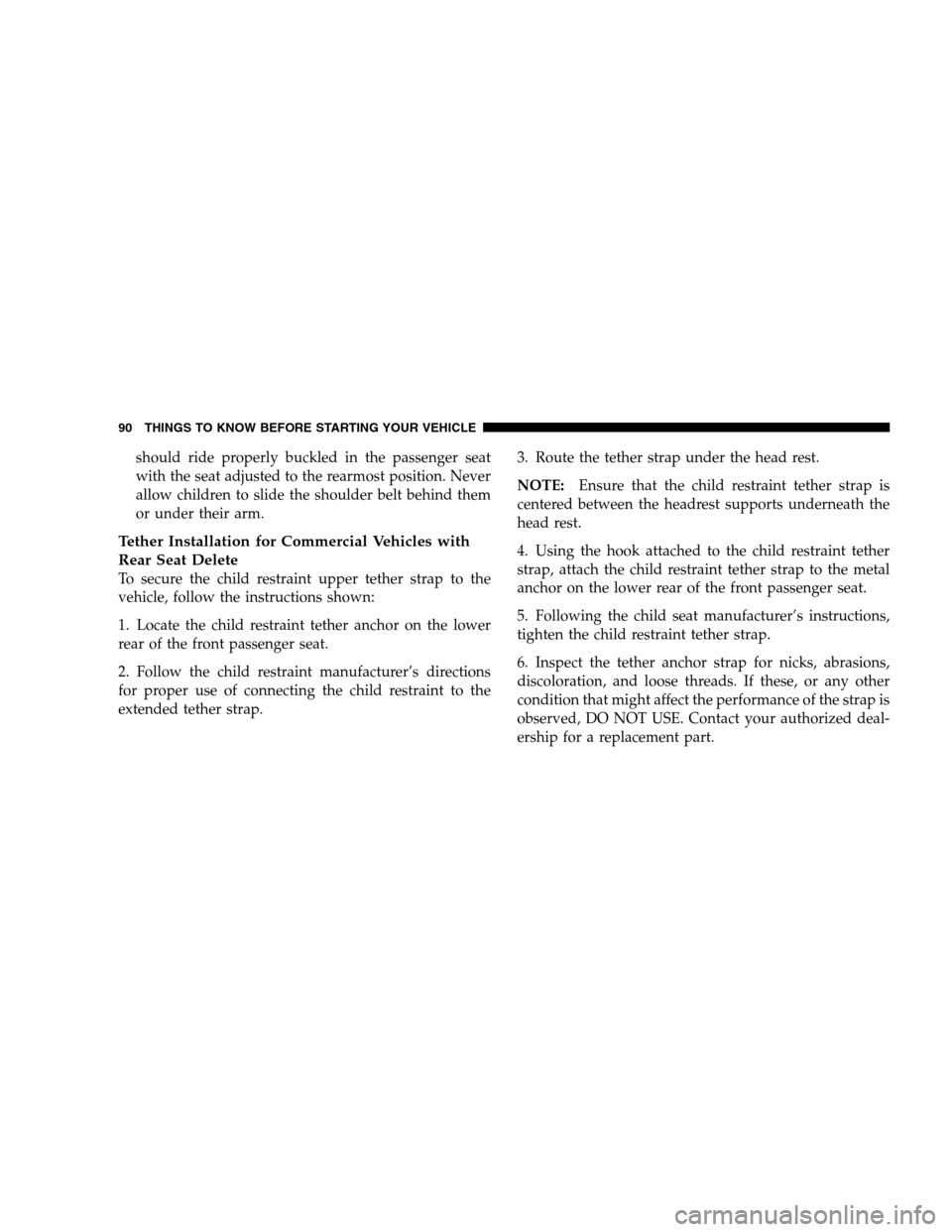
should ride properly buckled in the passenger seat
with the seat adjusted to the rearmost position. Never
allow children to slide the shoulder belt behind them
or under their arm.
Tether Installation for Commercial Vehicles with
Rear Seat Delete
To secure the child restraint upper tether strap to the
vehicle, follow the instructions shown:
1. Locate the child restraint tether anchor on the lower
rear of the front passenger seat.
2. Follow the child restraint manufacturer’s directions
for proper use of connecting the child restraint to the
extended tether strap.3. Route the tether strap under the head rest.
NOTE:
Ensure that the child restraint tether strap is
centered between the headrest supports underneath the
head rest.
4. Using the hook attached to the child restraint tether
strap, attach the child restraint tether strap to the metal
anchor on the lower rear of the front passenger seat.
5. Following the child seat manufacturer’s instructions,
tighten the child restraint tether strap.
6. Inspect the tether anchor strap for nicks, abrasions,
discoloration, and loose threads. If these, or any other
condition that might affect the performance of the strap is
observed, DO NOT USE. Contact your authorized deal-
ership for a replacement part.
90 THINGS TO KNOW BEFORE STARTING YOUR VEHICLE
Page 93 of 535
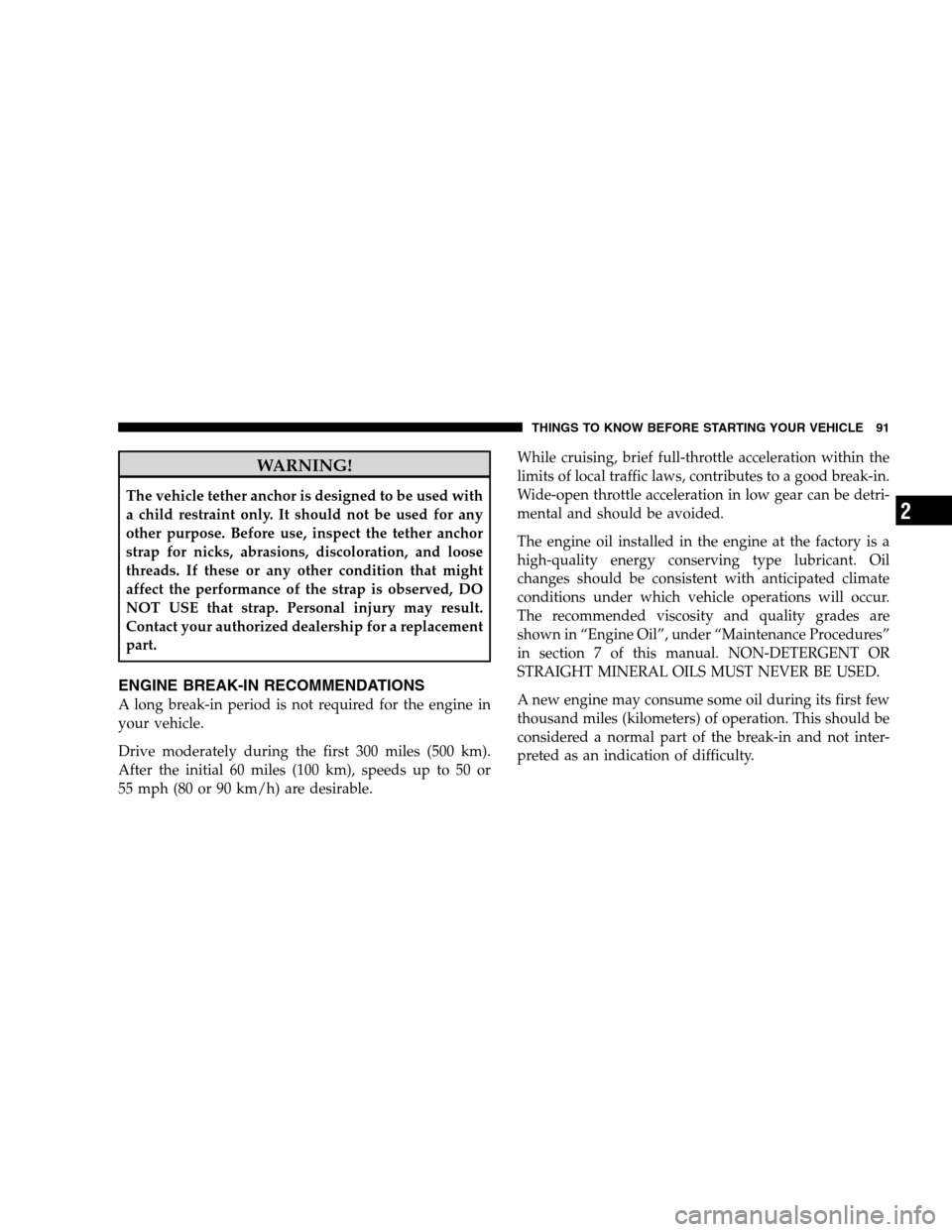
WARNING!The vehicle tether anchor is designed to be used with
a child restraint only. It should not be used for any
other purpose. Before use, inspect the tether anchor
strap for nicks, abrasions, discoloration, and loose
threads. If these or any other condition that might
affect the performance of the strap is observed, DO
NOT USE that strap. Personal injury may result.
Contact your authorized dealership for a replacement
part.
ENGINE BREAK-IN RECOMMENDATIONS
A long break-in period is not required for the engine in
your vehicle.
Drive moderately during the first 300 miles (500 km).
After the initial 60 miles (100 km), speeds up to 50 or
55 mph (80 or 90 km/h) are desirable.
While cruising, brief full-throttle acceleration within the
limits of local traffic laws, contributes to a good break-in.
Wide-open throttle acceleration in low gear can be detri-
mental and should be avoided.
The engine oil installed in the engine at the factory is a
high-quality energy conserving type lubricant. Oil
changes should be consistent with anticipated climate
conditions under which vehicle operations will occur.
The recommended viscosity and quality grades are
shown in “Engine Oil”, under “Maintenance Procedures”
in section 7 of this manual. NON-DETERGENT OR
STRAIGHT MINERAL OILS MUST NEVER BE USED.
A new engine may consume some oil during its first few
thousand miles (kilometers) of operation. This should be
considered a normal part of the break-in and not inter-
preted as an indication of difficulty.
THINGS TO KNOW BEFORE STARTING YOUR VEHICLE 91 2
Page 94 of 535
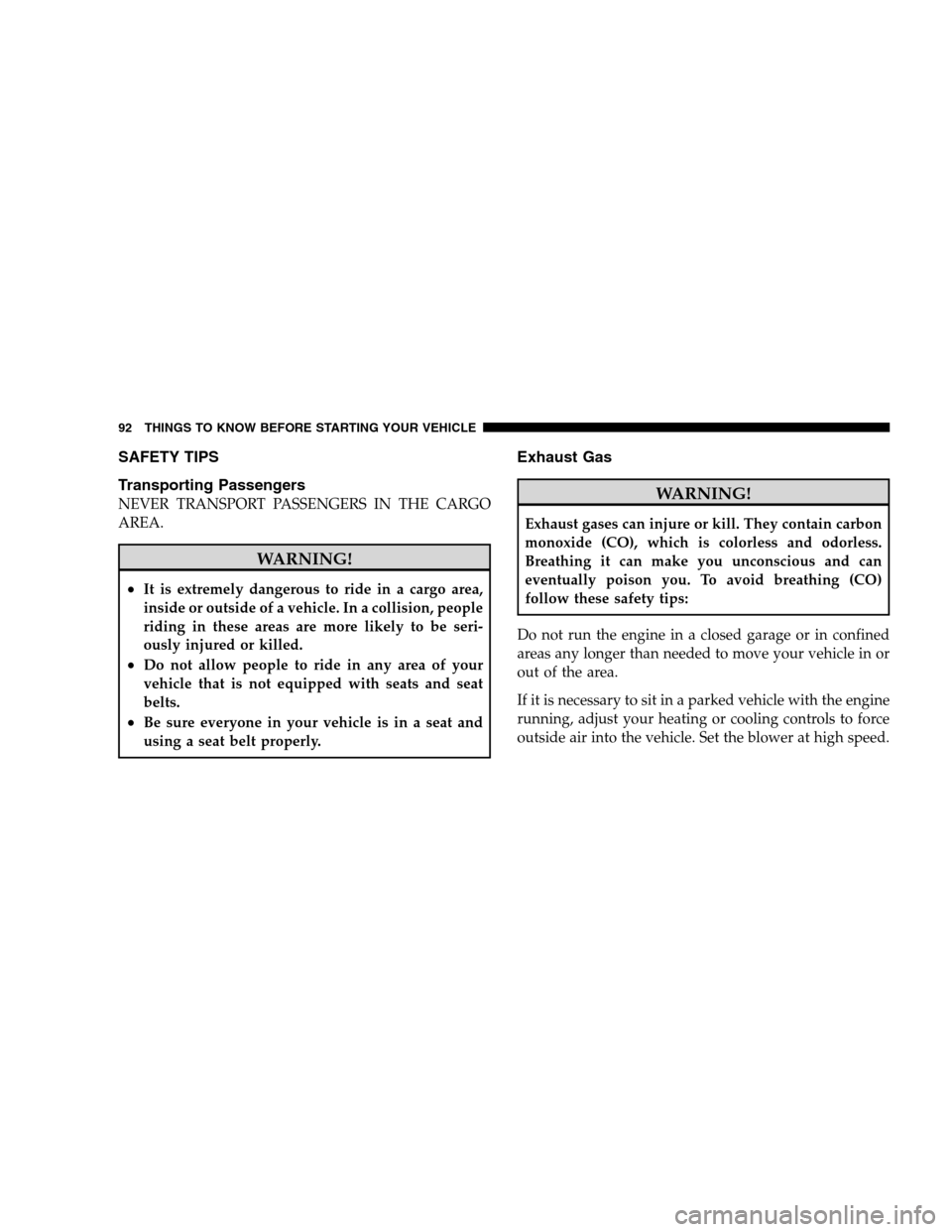
SAFETY TIPS
Transporting
Passengers
NEVER TRANSPORT PASSENGERS IN THE CARGO
AREA. WARNING!
It is extremely dangerous to ride in a cargo area,
inside or outside of a vehicle. In a collision, people
riding in these areas are more likely to be seri-
ously injured or killed.
Do not allow people to ride in any area of your
vehicle that is not equipped with seats and seat
belts.
Be sure everyone in your vehicle is in a seat and
using a seat belt properly.
Exhaust Gas WARNING!
Exhaust gases can injure or kill. They contain carbon
monoxide (CO), which is colorless and odorless.
Breathing it can make you unconscious and can
eventually poison you. To avoid breathing (CO)
follow these safety tips:
Do not run the engine in a closed garage or in confined
areas any longer than needed to move your vehicle in or
out of the area.
If it is necessary to sit in a parked vehicle with the engine
running, adjust your heating or cooling controls to force
outside air into the vehicle. Set the blower at high speed.
92 THINGS TO KNOW BEFORE STARTING YOUR VEHICLE
Page 95 of 535
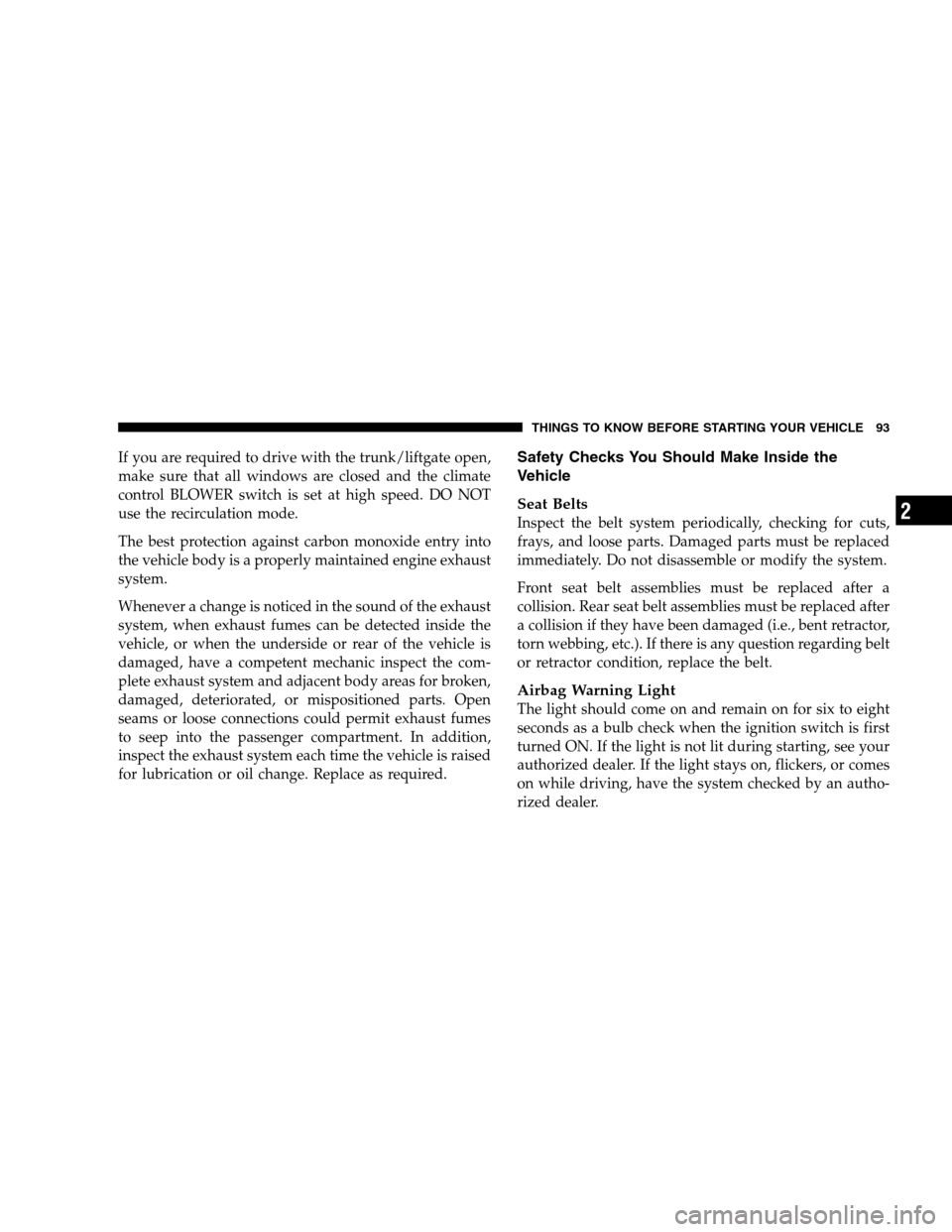
If you are required to drive with the trunk/liftgate open,
make sure that all windows are closed and the climate
control BLOWER switch is set at high speed. DO NOT
use the recirculation mode.
The best protection against carbon monoxide entry into
the vehicle body is a properly maintained engine exhaust
system.
Whenever a change is noticed in the sound of the exhaust
system, when exhaust fumes can be detected inside the
vehicle, or when the underside or rear of the vehicle is
damaged, have a competent mechanic inspect the com-
plete exhaust system and adjacent body areas for broken,
damaged, deteriorated, or mispositioned parts. Open
seams or loose connections could permit exhaust fumes
to seep into the passenger compartment. In addition,
inspect the exhaust system each time the vehicle is raised
for lubrication or oil change. Replace as required.Safety Checks You Should Make Inside the
Vehicle
Seat Belts
Inspect the belt system periodically, checking for cuts,
frays, and loose parts. Damaged parts must be replaced
immediately. Do not disassemble or modify the system.
Front seat belt assemblies must be replaced after a
collision. Rear seat belt assemblies must be replaced after
a collision if they have been damaged (i.e., bent retractor,
torn webbing, etc.). If there is any question regarding belt
or retractor condition, replace the belt.
Airbag Warning Light
The light should come on and remain on for six to eight
seconds as a bulb check when the ignition switch is first
turned ON. If the light is not lit during starting, see your
authorized dealer. If the light stays on, flickers, or comes
on while driving, have the system checked by an autho-
rized dealer.
THINGS TO KNOW BEFORE STARTING YOUR VEHICLE 932
Page 96 of 535
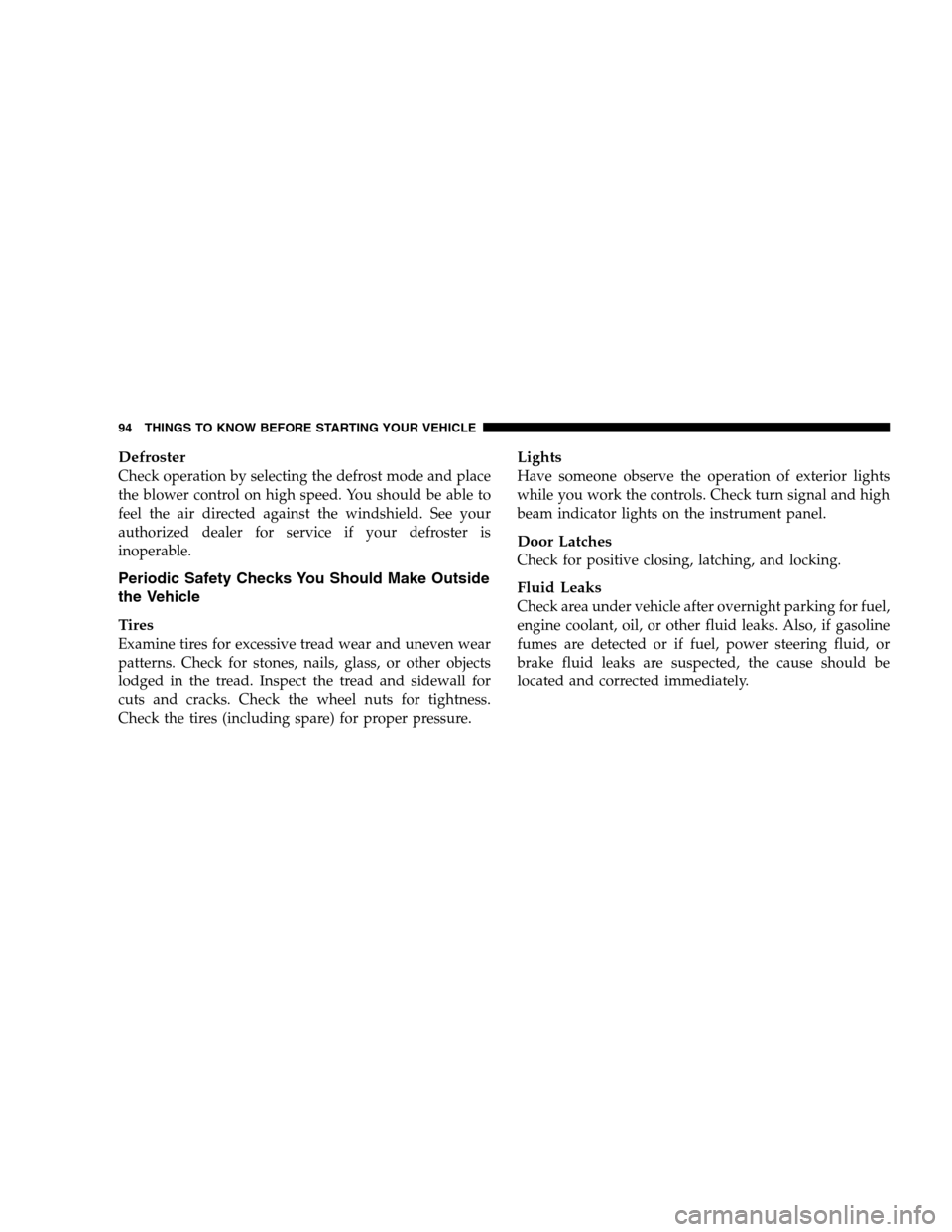
DefrosterCheck operation by selecting the defrost mode and place
the blower control on high speed. You should be able to
feel the air directed against the windshield. See your
authorized dealer for service if your defroster is
inoperable.
Periodic Safety Checks You Should Make Outside
the Vehicle
Tires
Examine tires for excessive tread wear and uneven wear
patterns. Check for stones, nails, glass, or other objects
lodged in the tread. Inspect the tread and sidewall for
cuts and cracks. Check the wheel nuts for tightness.
Check the tires (including spare) for proper pressure.
Lights
Have someone observe the operation of exterior lights
while you work the controls. Check turn signal and high
beam indicator lights on the instrument panel.
Door Latches
Check for positive closing, latching, and locking.
Fluid Leaks
Check area under vehicle after overnight parking for fuel,
engine coolant, oil, or other fluid leaks. Also, if gasoline
fumes are detected or if fuel, power steering fluid, or
brake fluid leaks are suspected, the cause should be
located and corrected immediately.
94 THINGS TO KNOW BEFORE STARTING YOUR VEHICLE
Page 97 of 535
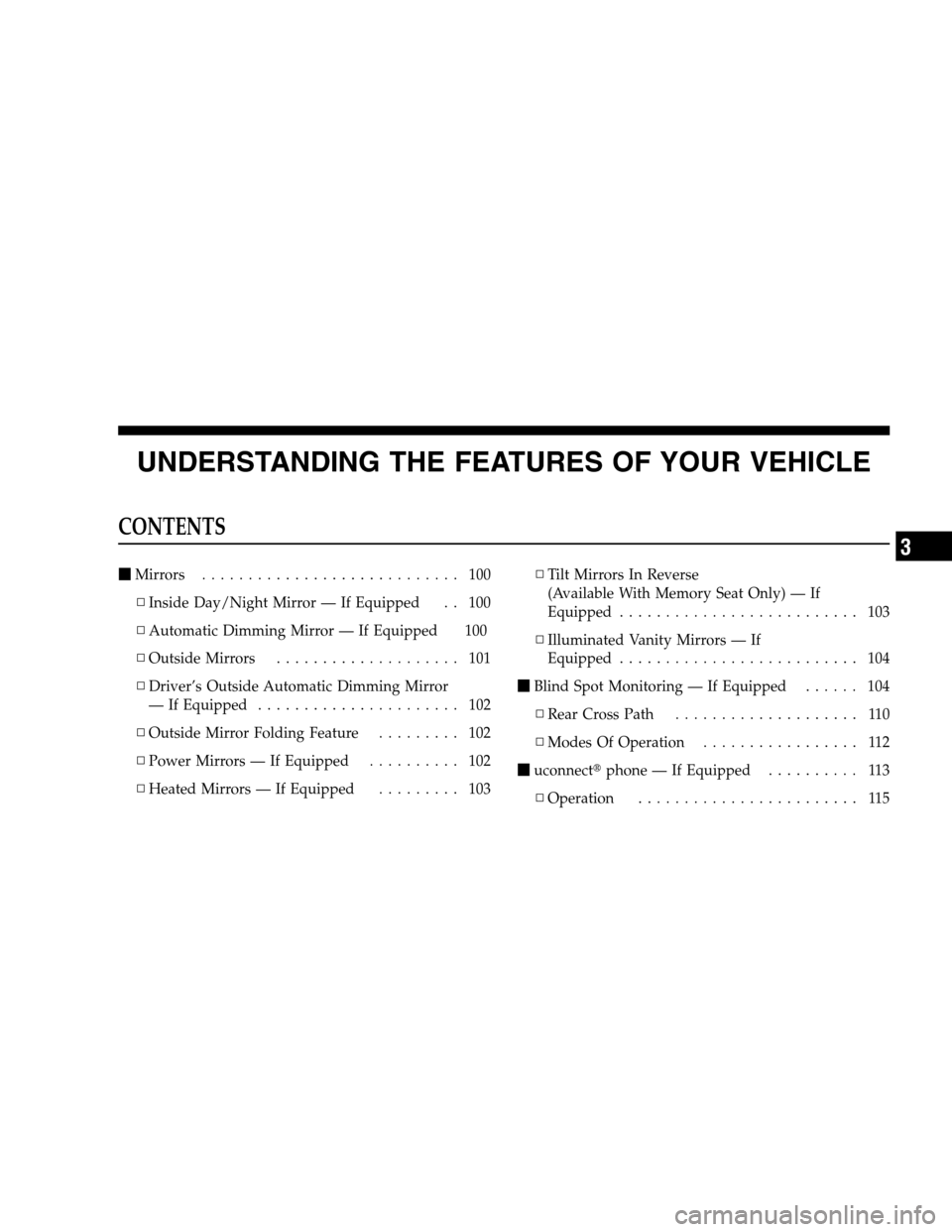
UNDERSTANDING THE FEATURES OF YOUR VEHICLECONTENTS
m
Mirrors . . . . . . . . . . . . . . . . . . . . . . . . . . . . 100
▫ Inside Day/Night Mirror — If Equipped . . 100
▫ Automatic Dimming Mirror — If Equipped 100
▫ Outside Mirrors . . . . . . . . . . . . . . . . . . . . 101
▫ Driver’s Outside Automatic Dimming Mirror
— If Equipped . . . . . . . . . . . . . . . . . . . . . . 102
▫ Outside Mirror Folding Feature . . . . . . . . . 102
▫ Power Mirrors — If Equipped . . . . . . . . . . 102
▫ Heated Mirrors — If Equipped . . . . . . . . . 103 ▫
Tilt Mirrors In Reverse
(Available With Memory Seat Only) — If
Equipped . . . . . . . . . . . . . . . . . . . . . . . . . . 103
▫ Illuminated Vanity Mirrors — If
Equipped . . . . . . . . . . . . . . . . . . . . . . . . . . 104
m Blind Spot Monitoring — If Equipped . . . . . . 104
▫ Rear Cross Path . . . . . . . . . . . . . . . . . . . . 110
▫ Modes Of Operation . . . . . . . . . . . . . . . . . 112
m uconnectt phone — If Equipped . . . . . . . . . . 113
▫ Operation . . . . . . . . . . . . . . . . . . . . . . . . 115 3
Page 98 of 535
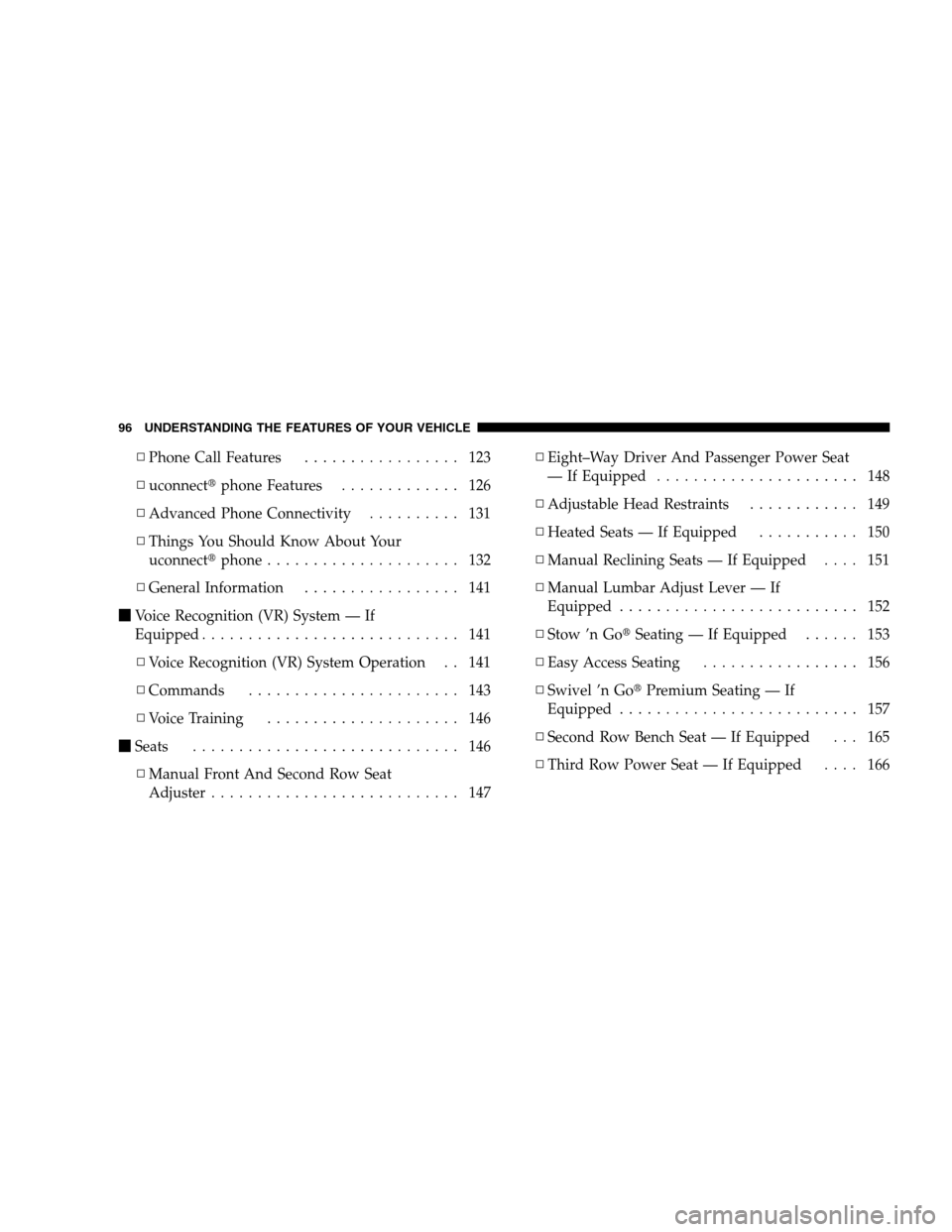
▫Phone Call Features . . . . . . . . . . . . . . . . . 123
▫ uconnectt phone Features . . . . . . . . . . . . . 126
▫ Advanced Phone Connectivity . . . . . . . . . . 131
▫ Things You Should Know About Your
uconnectt phone . . . . . . . . . . . . . . . . . . . . . 132
▫ General Information . . . . . . . . . . . . . . . . . 141
m Voice Recognition (VR) System — If
Equipped . . . . . . . . . . . . . . . . . . . . . . . . . . . . 141
▫ Voice Recognition (VR) System Operation . . 141
▫ Commands . . . . . . . . . . . . . . . . . . . . . . . 143
▫ Voice Training . . . . . . . . . . . . . . . . . . . . . 146
m Seats . . . . . . . . . . . . . . . . . . . . . . . . . . . . . 146
▫ Manual Front And Second Row Seat
Adjuster . . . . . . . . . . . . . . . . . . . . . . . . . . . 147 ▫
Eight–Way Driver And Passenger Power Seat
— If Equipped . . . . . . . . . . . . . . . . . . . . . . 148
▫ Adjustable Head Restraints . . . . . . . . . . . . 149
▫ Heated Seats — If Equipped . . . . . . . . . . . 150
▫ Manual Reclining Seats — If Equipped . . . . 151
▫ Manual Lumbar Adjust Lever — If
Equipped . . . . . . . . . . . . . . . . . . . . . . . . . . 152
▫ Stow ’n Got Seating — If Equipped . . . . . . 153
▫ Easy Access Seating . . . . . . . . . . . . . . . . . 156
▫ Swivel ’n Got Premium Seating — If
Equipped . . . . . . . . . . . . . . . . . . . . . . . . . . 157
▫ Second Row Bench Seat — If Equipped . . . 165
▫ Third Row Power Seat — If Equipped . . . . 166
96 UNDERSTANDING THE FEATURES OF YOUR VEHICLE
Page 99 of 535
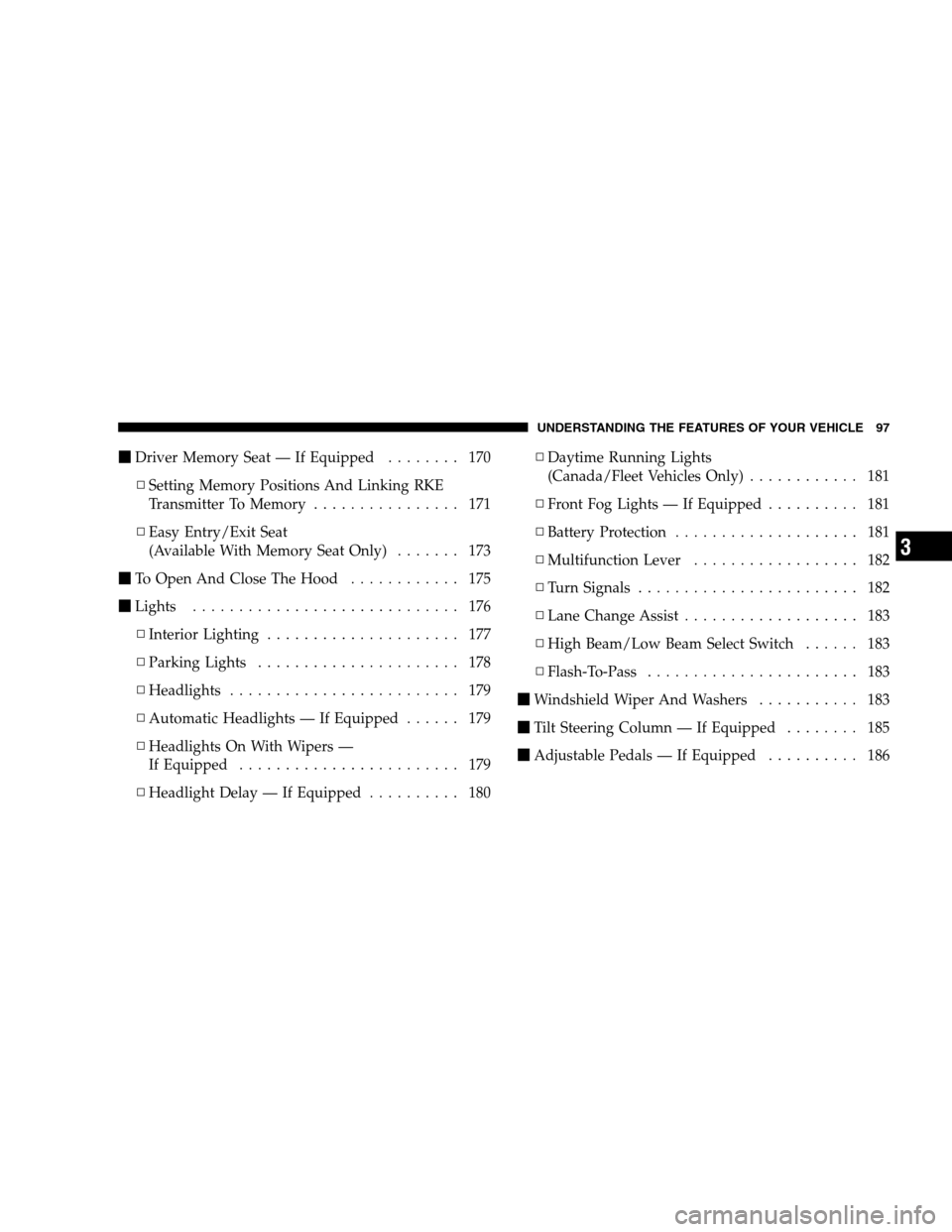
mDriver Memory Seat — If Equipped . . . . . . . . 170
▫ Setting Memory Positions And Linking RKE
Transmitter To Memory . . . . . . . . . . . . . . . . 171
▫ Easy Entry/Exit Seat
(Available With Memory Seat Only) . . . . . . . 173
m To Open And Close The Hood . . . . . . . . . . . . 175
m Lights . . . . . . . . . . . . . . . . . . . . . . . . . . . . . 176
▫ Interior Lighting . . . . . . . . . . . . . . . . . . . . . 177
▫ Parking Lights . . . . . . . . . . . . . . . . . . . . . . 178
▫ Headlights . . . . . . . . . . . . . . . . . . . . . . . . . 179
▫ Automatic Headlights — If Equipped . . . . . . 179
▫ Headlights On With Wipers —
If Equipped . . . . . . . . . . . . . . . . . . . . . . . . 179
▫ Headlight Delay — If Equipped . . . . . . . . . . 180 ▫
Daytime Running Lights
(Canada/Fleet Vehicles Only) . . . . . . . . . . . . 181
▫ Front Fog Lights — If Equipped . . . . . . . . . . 181
▫ Battery Protection . . . . . . . . . . . . . . . . . . . . 181
▫ Multifunction Lever . . . . . . . . . . . . . . . . . . 182
▫ Turn Signals . . . . . . . . . . . . . . . . . . . . . . . . 182
▫ Lane Change Assist . . . . . . . . . . . . . . . . . . . 183
▫ High Beam/Low Beam Select Switch . . . . . . 183
▫ Flash-To-Pass . . . . . . . . . . . . . . . . . . . . . . . 183
m Windshield Wiper And Washers . . . . . . . . . . . 183
m Tilt Steering Column — If Equipped . . . . . . . . 185
m Adjustable Pedals — If Equipped . . . . . . . . . . 186
UNDERSTANDING THE FEATURES OF YOUR VEHICLE 97 3
Page 100 of 535
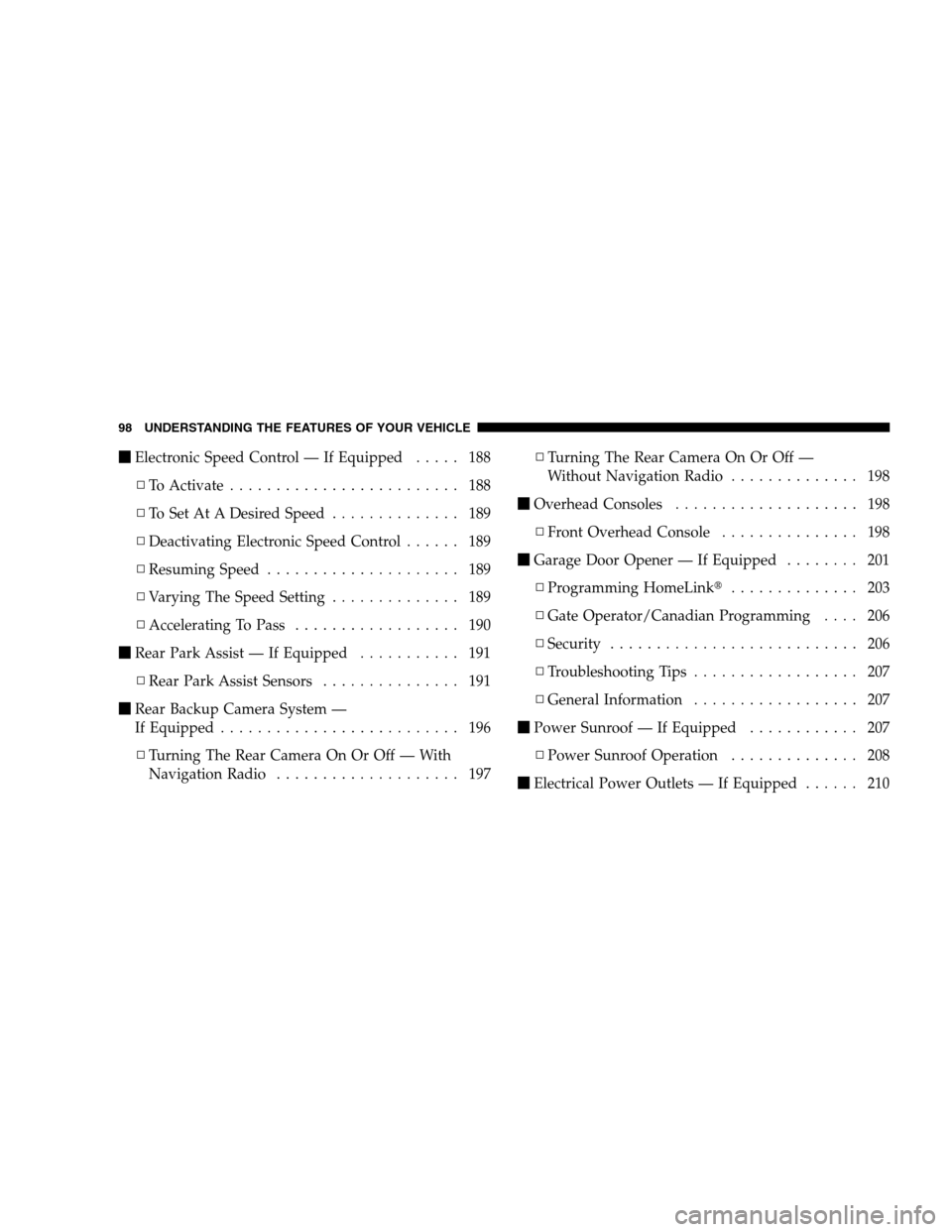
mElectronic Speed Control — If Equipped . . . . . 188
▫ To Activate . . . . . . . . . . . . . . . . . . . . . . . . . 188
▫ To Set At A Desired Speed . . . . . . . . . . . . . . 189
▫ Deactivating Electronic Speed Control . . . . . . 189
▫ Resuming Speed . . . . . . . . . . . . . . . . . . . . . 189
▫ Varying The Speed Setting . . . . . . . . . . . . . . 189
▫ Accelerating To Pass . . . . . . . . . . . . . . . . . . 190
m Rear Park Assist — If Equipped . . . . . . . . . . . 191
▫ Rear Park Assist Sensors . . . . . . . . . . . . . . . 191
m Rear Backup Camera System —
If Equipped . . . . . . . . . . . . . . . . . . . . . . . . . . 196
▫ Turning The Rear Camera On Or Off — With
Navigation Radio . . . . . . . . . . . . . . . . . . . . 197 ▫
Turning The Rear Camera On Or Off —
Without Navigation Radio . . . . . . . . . . . . . . 198
m Overhead Consoles . . . . . . . . . . . . . . . . . . . . 198
▫ Front Overhead Console . . . . . . . . . . . . . . . 198
m Garage Door Opener — If Equipped . . . . . . . . 201
▫ Programming HomeLinkt . . . . . . . . . . . . . . 203
▫ Gate Operator/Canadian Programming . . . . 206
▫ Security . . . . . . . . . . . . . . . . . . . . . . . . . . . 206
▫ Troubleshooting Tips . . . . . . . . . . . . . . . . . . 207
▫ General Information . . . . . . . . . . . . . . . . . . 207
m Power Sunroof — If Equipped . . . . . . . . . . . . 207
▫ Power Sunroof Operation . . . . . . . . . . . . . . 208
m Electrical Power Outlets — If Equipped . . . . . . 210
98 UNDERSTANDING THE FEATURES OF YOUR VEHICLE